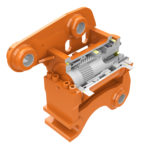Rotary actuators, in many cases, are a hybrid of linear and rotary actuators. Of course, in the fluid power realm, linear and rotary actuators are more affectionately referred to simply as cylinders and motors, respectively. A cylinder creates linear force when pressure acts up its piston’s surface area, while a motor creates rotational force when pressure acts upon its gears, pistons or vanes.

A rotary actuator may take elements from either cylinders or motors to create rotational force, also known as torque. The difference between a rotary actuator and a motor is the former rotates around a limited arc, while a motor may rotate infinitely.
There are two common types of rotary actuators. One system uses vanes inside a housing with physical stops to prevent the armature from rotating past 360 or less. The other system will use piston-based cylinders to convert linear force into torque via one of two ways.
The more common system employs a single or dual cylinder setup that cycles a rack back and forth against a pinion gear, rotating that gear and the output shaft anywhere along its operating range. The other, more complicated, system uses a piston with helical cut gears on both its outside and internal diameters. With force applied to its piston, the counter-rotating force on the OD spins the piston, which in turn spins the output shaft.
You use rotary actuators when your applications call for rotary actuation over a limited arc of travel. If your function requires the rotary actuator to cycle diametrically between 90 and 180 degrees, for example, hard stops prevent the actuator from moving to 89 degrees one way and 181 degrees the other.
Some rotary actuators are better suited to traverse their entire functional arc, such as the vane-type units. Sometimes their arc is adjustable, but they do well to rotate both directions continuously between their stops. Rotary actuators based on cylinders easily stop and hold their load anywhere along the stroke of the cylinder(s) on which they’re based. These limitations are very general because manufacturers provide customers with options to use rotary actuators full or partial rotation. Counterbalance, brake and PO checks valves may effectively hold a load locked in place, just as with the actuators upon which they’re based.
Rotary actuators are used in farm applications to rotate booms, arms or other devices over a particular range. They also allow the actuation of highly flexible joints, such as an optional scrap handling grapple attachment for an excavator. A boom conveyor on a stone slinger truck benefits from a rotary actuator, preventing the operator from over-extending in either direction. Rotary actuators are also excellent for material handling applications, such as bin tippers or pallet changers. Any application requiring rotary force over a limited arc is perfect for a rotary actuator from steering systems or automated positioning.





